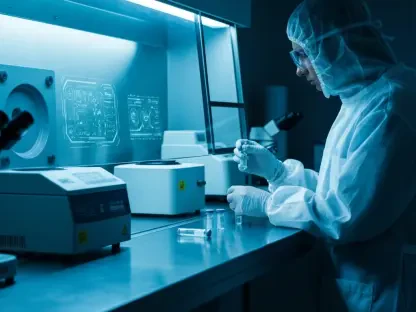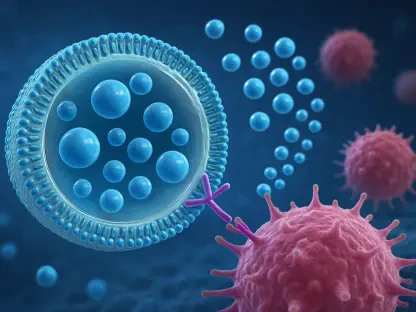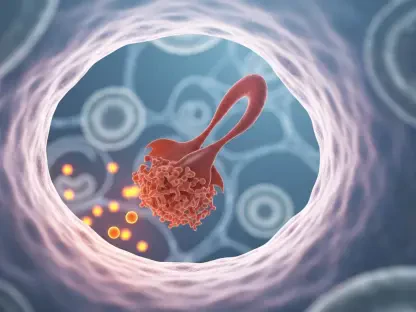In a groundbreaking stride toward transforming prostate cancer care, researchers have uncovered a potential game-changer that could redefine how this prevalent disease is tackled, offering new hope to millions of men worldwide. Prostate cancer remains the second most common cancer among men globally, often presenting significant challenges due to treatment resistance and limited options for advanced cases. A recent discovery by an international team from Flinders University in Australia and South China University of Technology has spotlighted two enzymes, PDIA1 and PDIA5, as critical players in the survival and progression of prostate cancer cells. This finding, published in a prestigious scientific journal, suggests that targeting these enzymes could disrupt the disease’s mechanisms at a fundamental level, offering hope for more effective therapies. As the medical community grapples with rising resistance to conventional treatments, this research opens a door to innovative strategies that could significantly improve patient outcomes and reshape the future of cancer management.
Unveiling a New Vulnerability in Cancer Cells
A pivotal aspect of this research centers on the role of PDIA1 and PDIA5 enzymes in protecting the androgen receptor (AR), a protein central to the growth and spread of prostate cancer. By inhibiting these enzymes, scientists observed that the AR becomes unstable and breaks down, leading to the death of cancer cells and a notable reduction in tumor size during lab experiments and animal studies. This mechanism presents a direct assault on the cancer’s ability to sustain itself, striking at a molecular level to dismantle its defenses. The implications of such a discovery are profound, as it targets a core driver of the disease rather than merely addressing symptoms or secondary effects. With prostate cancer often evading current therapies through adaptive resistance, identifying and exploiting this vulnerability could mark a significant shift in how aggressive forms of the disease are approached, potentially leading to more durable responses in patients who have exhausted other options.
Beyond the direct impact on the androgen receptor, the inhibition of PDIA1 and PDIA5 also disrupts the energy production of cancer cells by damaging mitochondria, often described as the powerhouse of the cell. This dual mechanism effectively cuts off both the fuel and the engine that cancer cells rely on to thrive under stress and continue proliferating. Such a comprehensive attack on the cellular machinery of prostate cancer underscores the potential of enzyme targeting as a robust therapeutic avenue. Moreover, this approach addresses a critical gap in current treatments, where cancer cells often adapt to survive harsh conditions induced by drugs. By impairing their energy systems alongside destabilizing key proteins, this strategy could reduce the likelihood of recurrence or progression, offering a more holistic way to combat the disease and improve long-term survival rates for men facing this challenging diagnosis.
Enhancing Treatment Through Combination Therapies
One of the most promising outcomes of this research is the enhanced efficacy seen when PDIA1 and PDIA5 inhibitors are paired with enzalutamide, a widely used drug for prostate cancer. The combination approach significantly boosts the effectiveness of treatment, making tumors more responsive to therapy and overcoming some of the resistance barriers that often hinder success. Senior researchers involved in the study have emphasized that this synergy not only destabilizes the androgen receptor but also amplifies the impact of existing medications, potentially reducing the dosage or duration needed for effective results. This could translate to fewer side effects and a better quality of life for patients undergoing treatment. As preclinical trials in patient-derived samples and animal models continue to show encouraging results, the path toward clinical application appears increasingly viable, paving the way for more personalized and potent therapeutic regimens.
However, the journey from lab to clinic is not without hurdles, as current inhibitors for these enzymes require further refinement to ensure safety and selectivity. Some compounds risk harming healthy cells alongside cancerous ones, a challenge that researchers are actively addressing through the development of more targeted alternatives. The focus over the coming years, potentially from now until 2027, will be on optimizing these inhibitors to minimize toxicity while maintaining their powerful anti-cancer effects. This meticulous process is crucial for translating laboratory success into real-world benefits, ensuring that patients can access treatments that are both effective and safe. The collaborative efforts of international teams and supporting organizations highlight a unified commitment to overcoming these obstacles, bringing hope that refined combination therapies could soon become a cornerstone of prostate cancer management.
Paving the Way for Future Innovations
Looking back, the strides made in identifying PDIA1 and PDIA5 as therapeutic targets represented a turning point in the battle against prostate cancer. The dual mechanism of destabilizing the androgen receptor and disrupting cellular energy systems offered a novel framework that challenged the disease on multiple fronts. Supported by global research initiatives and funding bodies, the work of dedicated scientists laid a strong foundation for addressing treatment resistance, a persistent barrier in achieving lasting remission. The preclinical evidence gathered during this period underscored the transformative potential of enzyme inhibition, setting a precedent for how molecular insights could drive clinical progress. Reflecting on these efforts, it became clear that the path forward required sustained investment in innovation to bridge the gap between discovery and application.
As a next step, the focus shifted toward actionable solutions, with an emphasis on accelerating the development of safer, more selective inhibitors through advanced drug design and rigorous testing. Collaborative networks across academia and industry were encouraged to prioritize clinical trials that could validate these findings in diverse patient populations. Additionally, integrating these therapies with emerging technologies like precision medicine could further tailor treatments to individual needs, maximizing impact. The ultimate goal remained steadfast: to enhance survival rates and quality of life for men worldwide by turning this promising research into accessible, effective care options that redefined the standard of prostate cancer treatment.









